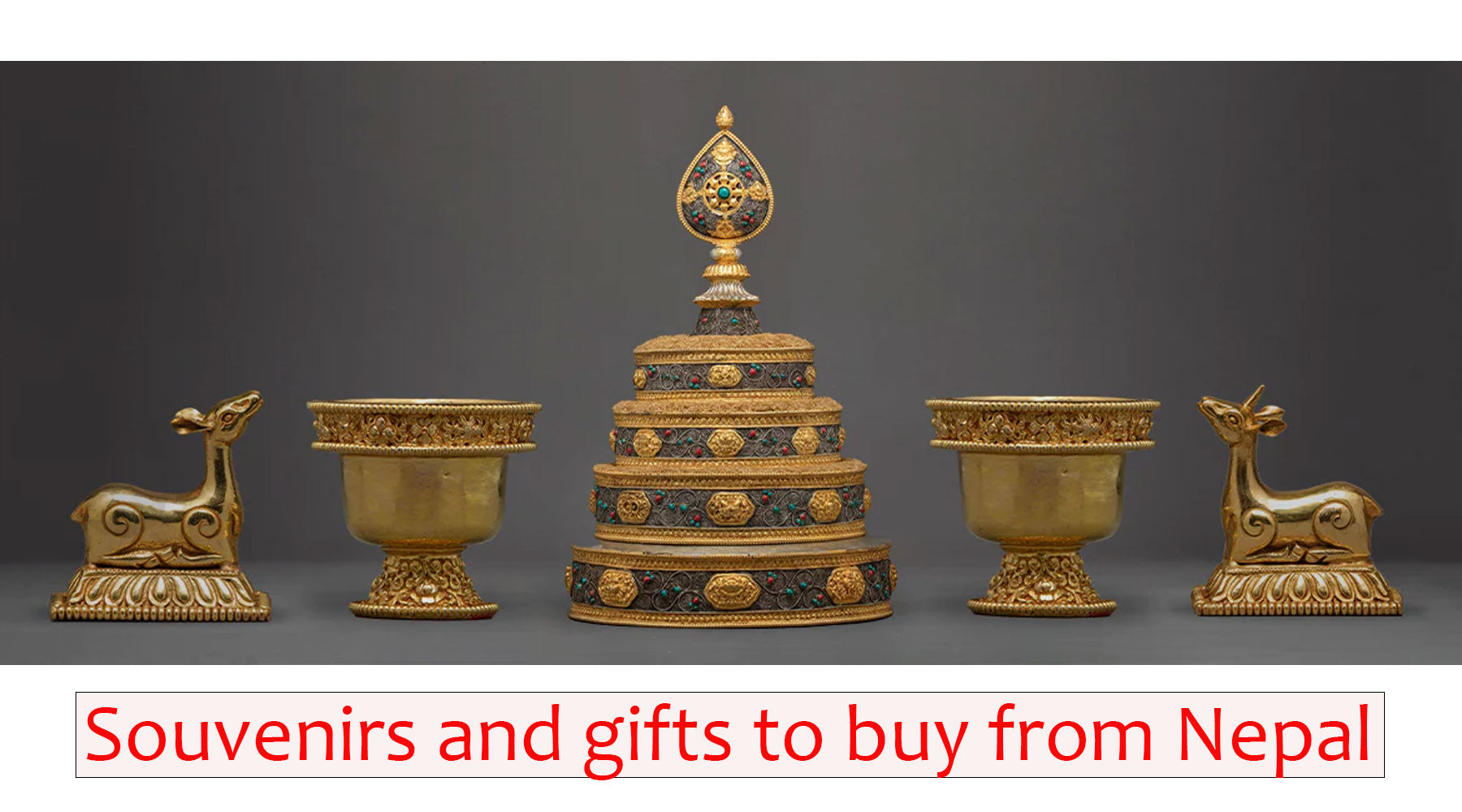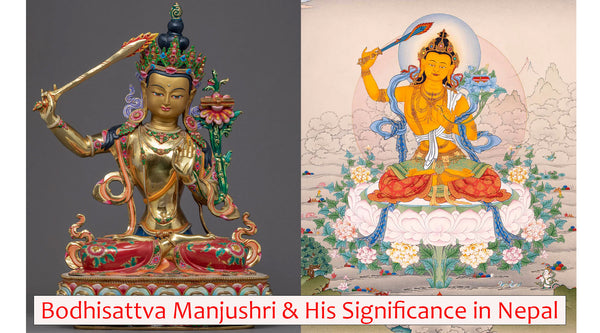A traditional act of Giving in Buddhism
Nepal, a nation nested between the magnificent Himalayas, is rich in and has a long-standing traditional culture associated with Buddhism. Nepalese handicrafts have been known for their exquisite and artistic crafts. The traditional expertise and craftsmanship are passed down to generations in paintings, wooden arts, sacred deities, sculpture carving, and carpet-to-woolen products. Which has quickly attracted the tourist's interest and earned fame in handcrafted worked the world market. This one-of-a-kind art and craftsmanship, the result of centuries of hard work and devotion, gives Nepal a distinct advantage in the export of handicraft goods.
Every traveler tends to get something as a souvenir no matter where they go to remind them of the places or events they have been to. Souvenirs could be anything that helps us to remind and appreciate the memories and moments for the rest of our lives. Once you have visited Nepal, separating yourself from Nepal may be difficult. If you're in Nepal and want to buy yourself some presents or mementos, wander through the neighborhood markets and businesses. There are many hidden things and tokens of love that you can take home with you.
In Buddhism, the practice of giving is counted as the merit of cultivating generosity. It has long been emphasized that one must adopt a more progressive open-handed, open-hearted outlook on life to advance spiritually. This emphasis dates to the Buddha. We must purposefully turn this around since taking and drawing attention to oneself are inherent human tendencies. Buddhism teaches that if we wish to advance toward the human state of enlightenment, which is the primary objective, we must enter the lives of others with empathy and imaginatively connect with their joys and suffering.
Shopping may be enjoyable, but it can also be a hassle if you don't know what to search for or, more significantly, where to look. Here are some suggestions for souvenirs that you might be interested in for your loved ones, friends, and even yourself before departing Nepal.
- Thangka Paintings

Thangka is highly regarded and holds special significance in Buddhist culture. It is generally employed to educate practitioners about the Buddha's life, times, customs, and other bodhisattvas. There are Thangkas painted with the sole aim of assisting you in your meditation practice that features representations of deities in various shapes, serving various tasks, holding multiple items, and signifying a wide range of things.
There are several uses for Thangka, not just by the core believers but also by others, for positive vibration, prayer, meditation, and spiritual practice. The Thangka swiftly transforms into a meditational tool for anyone who wants to contemplate Buddha's life and existence since it depicts Buddha's physical manifestations and distinctive characteristics. The Thangka's sanctity may be seen at first glimpse.
You can buy Thangka from different places. There are other shops located in the Boudha Area. One must be careful on selecting the Thangka as there are various factors to consider. Here's a guide on How to buy Thangka.
Price Range: $120- $8000
Where to buy: For the best quality Thangka, visit Enlightenment Thangka
- Singing Bowl

Since the beginning of human history, music and sound have been used as therapeutic tools to promote healing, meditation, and relaxation. Treatment is a traditional method of healing. Buddhist monks have used Himalayan singing bowls, Tibetan singing bowls, Tibetan healing bowls, and Tibetan meditation bowls for conventional musical instruments, ritualistic offerings, religious ceremonial music, meditation, and prayer from the beginning.
Tibetan meditational practice includes the use of singing bowls. It generates a sound that calms the mind and soothes the spirit. It has a therapeutic quality and produces a profound sensation of concentration. The quality of the Singing bowl varies with the materials used for its production. The bowl comprises seven types of precious metals, including gold, silver, and copper, and possesses reflective and therapeutic properties. One must get a Singing before departing from Nepal for the calming and meditative vibration properties.
Price Range: $110- $480
Where to Buy: For the best quality of Singing Bowl, visit EvamRatna Singing Bowl
- Buddhist Rituals Items

Items used in Buddhist rituals represent numerous aspects of Buddhism and its rich symbolism. In Tibetan Buddhism, many artifacts serve various purposes and help to set it apart from other forms of Buddhism. Tibetan Buddhists frequently offer them gifts and offerings to bring luck and fortune. The ceremonial objects can help ensure that everything goes according to plan and that the Buddha is aware of the aspirations of the gift bearer. Most Buddhist artifacts are exquisite and expertly made. They imitate precious metals and stones in terms of color, texture, and shape. Gold is a common theme throughout the artifacts.
There are many Buddhist Ritual Items such as; Altar Box, Bhuma Set, Butter Lamp, Chegumba, Dharma Wheel, Dhupur Rice Pot, Eight Auspicious Symbols, Ghau, Incense Burner, Kapala Set, Mandala Set, Offering Bowls, Prayer Wheel, Ritual Dagger, Serkyem, Stupa, Vajra & Bell.
Price Range: $100-$12900
Where to buy: Click here for the best handcrafted Buddhist Ritual Items
- Prayer Flags

According to Buddhist tradition, the first prayer flags were used by Gautama Buddha, whose teachings form the basis of Buddhism. Tibetan prayer flags' vibrant and attractive colors aren't simply for show. The flags are always set in a specific order, from left to right: blue, white, red, green, and yellow. Each color stands for an element. White stands for the air, blue for the sky, red for the fire, green for the water, and yellow for the ground. Together, the five colors represent equilibrium. Auspicious symbols, invocations, prayers, and mantras are on prayer flags.
Tibetan Buddhists have hung these flags outside their dwellings and centers of spiritual practice for millennia for the wind to spread the good vibrations over the area. According to legend, planting prayer flags will bring happiness, longevity, and wealth to the flag planter and others nearby. Anybody can hang prayer flags; nevertheless, there is a proper technique. To fulfill the flags' primary goal of disseminating positivity far and wide, it is crucial to have positive, altruistic reasons in mind. At the same time, you hang your flags wherever you decide to exhibit them.
- Tibetan Handmade Jewelry

- Source: Garland Magizine
Any jewelry item with Buddhist implications is referred to as Buddhist jewelry informally. This may take the shape of Buddhist symbols, patterns, or goals. When we wear jewelry, it has a purpose beyond merely making us look good. It continuously serves as a lovely reminder of a meaningful message to us.
The Buddhist Jewelry has different symbols such as an image of Shakyamuni Buddha, Utpala (Lotus), Traditional Dharma Wheel, Leaf of Bodhi Tree, Eternal Knot, Inscription of Om Mani Padme Hum, precious gemstones, corals, turquoise, Vajra, and many more.
Price Range: $100- $1000
Where to buy: Shops NearBoudhanath, Swayambhunnath Area
- National Weapon of Nepal- Khukri/ Khukuri

It also plays a significant role in the culture of Nepal, serving as a symbol of our nation's past, present, and future. In Nepalese culture, it represents riches, social standing, and prestige. As a piece of clothing, it even has a specific social function. For instance, a well-dressed groom from Nepal would never consider attending his wedding ceremony without a nice Khukuri at his side.
Due to its adaptability on the battlefield, the Khukuri gained notoriety in the western world. The Khukuri, which the Gurkhas were adept at using, served as an extension of their arm. The most courageous combatants in the world are Gurkhas. You can take this national weapon as a token of love or gratitude towards Gurkhas.
Price Range: $20-$900
Where to buy: Shops Near Boudhanath, Swayambhunnath, Pashupatianath Area
- Gold Plated Statue

For decades, producing handicrafts for Tibetan monasteries has helped Nepali artisans polish their technique. The best sculpting methods were developed throughout time by a small group of the most skilled craftspeople, who tightly guarded their knowledge. The Kathmandu Valley's artisans have created Buddhist ceremonial items in addition to sculptures of deities.
Different types of statues differ in size, weight, materials used to mold them, various gemstones, corals, gliding with genuine 24K gold or silver plating, and acrylic colors. One can select these as per their need, whether it is meant for sadhana practice, meditation, Buddhist Rituals, or simply home décor.
Price Range: $135-$33,500
Where to buy: Termatree
- Prayer Wheels

The prayer wheels can be found as little lockets, pendants, with handles, or in a frame, from tiny hand-held wheels to big wheels built into a building's wall that may be moved about like movable pillars. Many Tibetans utilize prayer wheels every day, sometimes for extended periods. Turning prayer wheels helps devotees accumulate merit, benefit all living things, and purify their karma (intentional actions). They are a component of meditation.
Prayer wheels are filled with different copies of mantras. This will be a perfect tool to aid you in your daily practice. You can get it in different sizes filled with varying mantras as required per your sadhana, which is the best aspect of the tool. The most popular type of Tibetan prayer wheel made by hand is the Mani wheel. It features a cylindrical metal body fixed on a rotating handle made of metal or wood. The cylinder contains a string or chain that makes it simple to spin with just a tiny amount of rotation.
Price Range: $10-$500
Where to buy: Shops Near Boudhanath, Swayambhunnath Area
- Mala Beads

These unique beads have been used for thousands of years and are known as malas (or Japa Malas). Although they have their deepest roots in India and Nepal, where meditation has been practiced for the longest, you can find them practically anywhere around the globe. Anyone can utilize mala beads to bring tranquility and peace of mind into daily life. Even though anybody may start using malas without any prior expertise, they are employed in traditional prayer and meditation.
During spiritual meditation, malas assist one's awareness, and attention becomes more focused. In contrast to wrist malas, which are shorter, long males have 108 beads. The guru bead, also known as a Sumeru, is the summit or head bead. One mala in Tibetan Buddhism equals 100 mantra recitations. To guarantee optimal attentiveness, there are an additional 8 recitations performed.
Price Range: $1-$100
Where to Buy: Boudhanath, Swayambhunnath Area Shops


